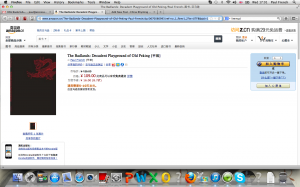Posted: April 2nd, 2013 | No Comments »
Amongst contemporary China studies, it seems to me, there is a big gap when it comes to studies of racism in China. Not quite sure why this is? Anyway, this relatively new book – Ian Law’s Red Racism – is interesting and, though China is just one component among many communist regimes, it is instructive in terms of how to think about the origins of racism, its development and practise in contemporary Chinese society. China, like most other Marxist-Leninist regimes, effectively claimed to have ended racism by the mere fact of its triumph. Since then, 1949 in China’s case obviously, it’s been an official programme of straightforward denial that there is any racism either towards outsiders or ethnic minorities within the country (taking the country to mean what Beijing thinks it means and so including Tibet here).
There are a lot of issues regarding treatment of minorities in other Communist countries that will sound familiar to anyone with a passing acquaintance with the PRC – the language of “modernising” minorities and bringing “development” to them, ending “primitivism” and “feudal practises” as well as that particularly hoary old chestnut that rings down from the British Empire to Lhasa today – bringing “civilisation”. The Chinese communist lexicon is almost identical to the wider Communist lexicon globally. What all this adds up to of curse is racism, structural racism and oppression. It doesn’t help that many of the long-lasting Round Eye Gang of sympathisers – the useful idiots – have perpetuated the myths of the Chinese state on race by claiming that China was racism free or that the relentless push to urbanism in China disregards any minority’s intrinsic or traditional links with land. So many issues and many raised in this book.
It is to be hoped that someone may take on this subject in more depth and concentrate on China….
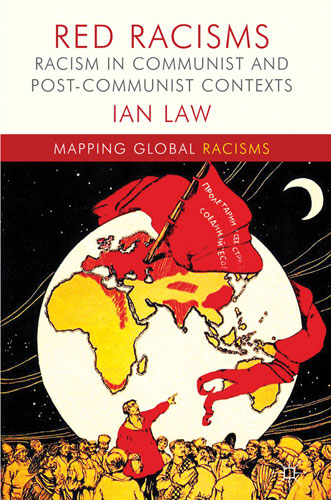
Racism in the Soviet Union and in other Communist contexts has frequently been denied and ignored. This is the first book to provide an analysis of racism and racialization in Communist and post-Communist contexts. It opens up debates about both the relationship between racism and communism and the racial logics at work, how they have come into being and how they have changed in the contemporary world. This is a major advancement in our understanding of processes of global racialization and this book includes new analysis and evidence on the battle to challenge the racist underground in the Russian Federation, the postwar experiences of the Roma in Hungary, Romania, Slovakia and the Czech Republic, new Afro-Cuban movements and on Tibetan struggles against Chinese domination.
Ian Law is Professor of Racism and Ethnicity Studies in the School of Sociology and Social Policy, University of Leeds and founding Director of the Centre for Ethnicity and Racism Studies, UK. His major books include Ethnicity and Education in England and Europe (with S. Swann), Racism and Ethnicity, Racism, Postcolonialism and Europe (edited with Huggan), Institutional Racism in Higher Education (edited with Turney and Phillips), Race in the News, Racism, Ethnicity and Social Policy, Local Government and Thatcherism (with Butcher, Leach and Mullard) and The Local Politics of Race (with Ben-Tovim, Gabriel, and Stredder).
Posted: April 1st, 2013 | No Comments »
As the weather starts to take a turn for the better but remains damp beware HongKong Foot, a rather nasty version of what is more commonly known these days as Athlete’s Foot. HongKong Foot was a major problem for Shanghailanders in the humid damp climate of the treaty port and the newspapers of the inter-war years are full of adverts for various potions, powders and creams (“unctions” might be a more contemporary term). Aunt’s Ointment was certainly among the most heavily advertised in the 1930s (this ad is from the North-China Daily News in 1934)
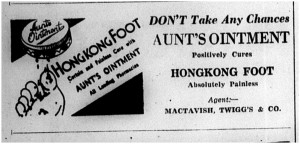
Posted: March 31st, 2013 | No Comments »
Limmud is an organisation dedicated to Jewish learning in all its variety, apparently. Anyway, they’re coming to Shanghai for a Limmud China event. A ton of Jewish and China related stuff going on over the 4/5th of April – Qingming Festival – all out at Qibao Watertown near Shanghai. I’m speaking on the 4th on Recovering Lost Jewish Lives and some of the mad, bad and murdered Jews of old China that have got a bit lost over the years…more details here.
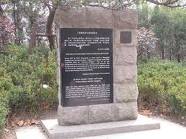 The memorial to the Jewish Ghetto of Shanghai in Wayside Park (now Huoshan Park)
The memorial to the Jewish Ghetto of Shanghai in Wayside Park (now Huoshan Park)
Recovering Lost Jewish Lives in China: Yiddish Tears on the Bubbling Well Road, Paul French
Hardoon, Sassoon, Kadoorie, Ezra… all familiar names whose histories are well documented. But what of those less dramatic Jewish lives, what of those Jews in China who remained largely anonymous or lived on the fringes, in the margins or among the underbelly? Longtime Shanghai resident and NYT bestseller author Paul French will tell stories of those Jews in China, including where they danced all night in the 1940s Shanghai Ghetto; how Eliza Shapera was trafficked from a Bessarabian shtetl to a Shanghai bordello — and then murdered; how Mr. Kahn ended up in the Russian-Jewish slum of Yang-I-Hutung in Peking; who killed Sammy Weingarten in the Red Rose Cabaret, how Joe Farren ran away from Vienna’s Jewish ghetto, nearly became Shanghai’s biggest gangster and married Shanghai’s “Josephine Baker”; and why grown men cried when Lily Flohr sang in Yiddish on the Bubbling Well Road.
Posted: March 30th, 2013 | No Comments »
 I was recently back in Adelaide for the Writers’ Week and some meetings and took the opportunity once again to visit the marvellous Carrick Hill, a gorgeous 1930s period home in South Australia. Lovely as it is the real reason Carrick Hill is a treasure house is its art collection. Among the collection there are any number of Stanley Spencer’s, Jacob Epstein’s, Augustus Johns, not to mention a Gaugin, Vuillard and Boudins. Along with the Europeans there is a good collection of Australian artists less familiar to me. On both trips there that I have made one picture has stood out as amazingly impressive and I thought I’d share it as it is called The Chinaman’s Store painted in 1949 by Russell Drysdale. It sits in the dining room in a prominent place and so must have been precious to the owners too. I’m afraid this is the best version of it I have found online and it gives no hint of the beautiful colours or the sense (as several of us looking at it agreed) of a South Australian Edward Hopper painting…here’s a bit on the painting:
I was recently back in Adelaide for the Writers’ Week and some meetings and took the opportunity once again to visit the marvellous Carrick Hill, a gorgeous 1930s period home in South Australia. Lovely as it is the real reason Carrick Hill is a treasure house is its art collection. Among the collection there are any number of Stanley Spencer’s, Jacob Epstein’s, Augustus Johns, not to mention a Gaugin, Vuillard and Boudins. Along with the Europeans there is a good collection of Australian artists less familiar to me. On both trips there that I have made one picture has stood out as amazingly impressive and I thought I’d share it as it is called The Chinaman’s Store painted in 1949 by Russell Drysdale. It sits in the dining room in a prominent place and so must have been precious to the owners too. I’m afraid this is the best version of it I have found online and it gives no hint of the beautiful colours or the sense (as several of us looking at it agreed) of a South Australian Edward Hopper painting…here’s a bit on the painting:
THE CHINAMAN’S STORE, 1949, is also a close study of the character of a vulnerable Australian country town – a simply built but solidly enduring place in a desolate, spacious and harsh landscape.
In this painting, unlike his usual “figure in the landscape” works, Drysdale has omitted any reference to the town’s inhabitants; the buildings must also stand as a reflection of the character of the people. However, this feature also serves to heighten the sense of desolation and desertion. The composition is simple: the store stands in the right-hand foreground opposite a nondescript wooden house, and in the background are several other houses and distant hills.
What might otherwise be an uninteresting scene is relieved by the richness of Drysdale’s colours. The various shades of brown, yellow and red, reminiscent of the colours of Venetian painting, characterise the “essence” of the land, and these are placed against a bright blue sky which serves to give a sense of the heat of the day. Patches of green grass hug the store’s verandah floor, softening the raw adjacent dusty thoroughfare.
Drysdale has no intention of hiding the ugliness of the scene, but presents it with authenticity and dignity. This is not the promised Utopia, but an exhausted, precarious landscape, in which the ghosts of defeated inhabitants linger on.
Adding to the feeling of unease and eeriness in this melancholy settlement, the dry road peters out into the infinity of a countryside which although invaded has not been subdued.

Posted: March 29th, 2013 | No Comments »
An interesting event if you happen to be Chengdu way…
Architecture and the Landscape of Modernity in China before 1949
Edward Denison and Guang Yu Ren
Sunday, March 31st, 5:30pm
Chengdu Bookworm
FREE
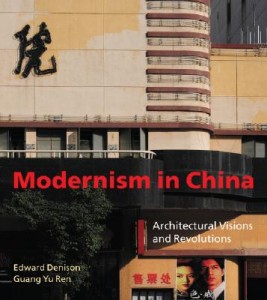
With building traditions spanning nearly five millennia, China boasts the longest continuous architectural lineage in history. Today, the country’s architectural aspirations are equally unprecedented, forming an omnipresent backdrop to the country’s glass-clad high-rises. However, linking past and present was a period of modernisation that revolutionised China’s architectural landscape and has been largely overlooked.
The history of China’s architectural encounter with modernity offers twenty-first century observers a unique insight into one of the most unprecedented and important manifestations of modernism outside the West – where the formation of an architectural modernism in China derived not only from the West, but also from the East.
Edward Denison is an independent consultant specialising in architectural and urban history.
Guang Yu Ren is a researcher and consultant specialising in architecture and the built environment. Guangyu is now based in London where she works as an advisor to firms working in China and co-authors books on architecture and design with Edward Denison.
Posted: March 29th, 2013 | No Comments »
A Shanghai RAS event of possible interest…
Hidden Treasures: An Exploration of Antique Maps of China and Asia, 16-18th Century
Vince Ungvary
Saturday 30th March, Registration 3:30 PMÂ – starts at 4:00 PM
The Tavern, Radisson Blu Plaza Xingguo Hotel 78 XingGuo Road, Shanghai

The history of Europe’s interactions with Asia is no better documented than through the maps that were produced by Europeans over a long period of time. From the time of Ptolemy in 150AD, maps of Asia had showed parts of the continent based on the scant information at the time provided by explorers and traders. For the next 1500 years, maps of Asia hardly changed from the Ptolemaic tradition. Even Marco Polo’s famous travels to China in the 13th century didn’t substantially alter the European conception of Asia’s geography although it did provide the impetus for the Age of Exploration by the Portuguese and the Spaniards in the 16th century to the Asian region. The search for trade opportunities, particularly of gold, silver and spices as well as silk and porcelain led to other nations joining the fray including England and Holland in the early to late 17th century. The Age of Exploration eventually led to European imperialism in Asia as Europe flexed its economic, political and technological muscle across the region.
Vince Ungvary is a graduate of Asian studies from Murdoch University, Perth, Western Australia where he majored in Modern Chinese History and Indonesian. Subsequent to his degree, Vince completed a post graduate degree of Marketing at Edith Cowan University, Perth. Vince has worked in the Asian region since 1991, first in Jakarta, Indonesia and then for the last 10 years in Shanghai.
Vince took up his passion of map collecting 15 years ago when he visited a house on the outskirts of New Delhi, only to find it was actually an antique bookstore and full of antique maps of Asia. Vince has since built his map collection which focuses mainly on Antique maps of Asia and China from the 16th century to the 19th century (and a few rare ones of pre-1949 Shanghai) to a collection of around 800 maps.
We will follow this course of history by seeing the changes in European conception and knowledge of Asia and China through the eyes of the map makers of those times. Actual examples of antique maps of Asia and China from the 1500’s, 1600’s and 1700’s will be displayed from Vince’s collection.
Next The Exhibition:
Walk along to
HONG MERCHANT GALLERY
N° 3 Lane 372 Xing Guo Road
(by Huaihai Road), Shanghai
To view Exhibition
Exhibition time: 5.45pm
Talk Cost: RMB 80.00 (RAS members) and RMB 130.00 (non-members). Includes one drink of 150 ml. glass of red or white wine/draft beer/soft drink/ tea or coffee. Those unable to make the donation but wishing to attend may contact us for exemption.
Exhibition Cost: Free
Membership applications and membership renewals will be available at this event.
RAS Monographs: Series 1 & 2 will be available for sale at this event. RMB 100 each (cash sale only).
To RSVP:Â Please “Reply” to this email or write to
RAS Bookings at: bookings@royalasiaticsociety.org.cn
Posted: March 28th, 2013 | No Comments »
An interesting post on Shanghaiist about the St Nicholas Russian Orthodox Church on Gaolan Road (formerly Rue Corneille in the old French Concession). Shanghailander Russians, it seems, got in there to have a service. The place has been through many incarnations – I remember the old Ashanti Dome restaurant well which was quite lovely (I don’t recall if the food was any good though). I posted back in 2009 about the “refurbishment” of the Church, built in 1934 – even in the Ashanti Dome days the nipples of the females painted in the frescoes on the ceilings had been covered by some purist Communist!! I thought it had been turned into a coffee shop for retired Communist Party cadres, but haven’t wandered down that streets for ages. The addition of a disco ball is rather disconcerting whether you consider the building a Commie retirees cafe or a Russian Orthodox Church really!! Anyway pics on Shanghaiist.
Posted: March 27th, 2013 | No Comments »
For anyone in China – just to let you know the limited edition (only available in Hong Kong, China and Australia) of my forthcoming e-book (everyone in the next couple of months) The Badlands: Decadent Playground of Old Peking, which is some back stories from the characters of the Peking Badlands in Midnight in Peking (now by the way just UK4.99 on Amazon.co.uk), is available on Amazon China here.
